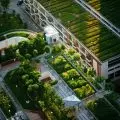Olympic Games architecture has undergone considerable evolution over the years, from simple structures to complex, innovative designs that often become iconic symbols of host cities. These transformations reflect changing design philosophies, technological advances and cultural shifts.
it used to be
Not everyone knows that architecture was once an official Olympic discipline. For the father of the modern Olympic Games , Pierre de Coubertin, competitions in the arts were part of his original intentions for the modern Olympic Games.
De Coubertin argued:
At the height of Olympia, the fine arts blended harmoniously with the Olympic Games to create their glory. This is to become a reality again.
Between 1912 and 1948, medals were awarded in five artistic categories, including architecture. The first competition in this category was held at the 1912 Stockholm Olympics, where concepts aimed to link design to sports.
One of the first projects awarded was the "Plan for the Construction of a Modern Stadium" by Swiss architects Eugène-Edouard Monod and Alphonse Laverriére, which won a gold medal.
Also, the "urban design" category was a discipline in the Olympic art competitions. Competition in this category took place for four consecutive editions of the Games, starting in Amsterdam in 1928, Los Angeles in 1932, Berlin in 1936 and London in 1948. These competitions included projects that often focused on sports stadiums, public parks and recreational centers.
panta rhei
It is not only the disciplines that change at the Games, the architecture of the Games also transforms over time. If we look back in time, we can see that the development of architecture in this field reflects both the historical context of the Games and architectural innovations. Three main phases can be distinguished in current Olympic architecture: the early modern Games (1896-1960), the Games of the 2nd half of the 20th century (1960-2000) and the modern Games (2000-present).
The cover of the official announcement of the 1896 Summer Olympics in Athens.
©Public domain
early modern games (1896-1960)
The first modern Games in Athens in 1896 inaugurated a new era of sports architecture. The Games were characterized by architecture focused mainly on functionality and classical forms. The Athens event made use of the renovated ancient Panathinaiko Stadium, emphasizing the link to ancient tradition. The stadium, made of marble, witnessed the birth of the modern Olympic movement. Its classical design, inspired by ancient stadiums, became a symbol of the drive to renew ancient Olympic traditions. The designs of venues in this phase often referred to classical architecture, symbolizing the continuity of the Olympic tradition. The emphasis was on the practicality and basic functionality of sports facilities.
Panathenaico Stadium - a 19th-century reconstructed version of a stadium from the 2nd century AD
Photo: George E. Koronaios | © Creative Commons Attribution-Share Alike 4.0 International license
mid-20th century games (1960-2000)
In the 1960s and 1970s, Olympic architecture began to reflect technological advances. An example is the Munich Olympic Stadium, designed by Otto Frei for the 1972 Games. Its distinctive roof, reminiscent of stretched fabric, was a symbol of the new democratic Germany, and inspired later stadium designs around the world. Olympic architecture began to be seen as a way to express national identity and technological ambitions. New materials and construction techniques were experimented with, creating bold and futuristic designs.
Munich Olympic Stadium, view from the Olympic Tower, 2006.
© Radox, public domain
modern games (2000-present)
The modern Games place great emphasis on the long-term use of facilities. Projects take into account environmental aspects and energy efficiency. One example is the National Stadium in Tokyo, which uses local wood from areas recovering from earthquakes, such as Aomori, Iwate, Miyagi and Kumamoto prefectures. The stadium's design, which is in line with the idea of recovery and reconstruction, aims to minimize environmental impact and emphasize Japanese traditions. The stadium features a modular structure inspired by the Hōryū-ji temple, with eaves for natural ventilation. It features transparent solar panels and a rainwater harvesting system for plant irrigation. Attention to accessibility includes more than 450 seats for people with disabilities.
Currently, more emphasis is being placed on post-Olympic planning so that facilities can serve the community after the Games. Today, Olympic architecture seeks to be a catalyst for urban development and urban revitalization.
time is not an ally
One of the most important aspects in thinking about the Games from an urban planning perspective is the aging of facilities. This is a challenge for host cities that is being talked about more and more. This is because most venues resemble one-hit wonders (one-hit artist) songs. Magnificent buildings that accommodate hundreds of thousands of fans and athletes at an event have a problem with aging.
The cost of maintaining such large and often spectacular, innovative venues requires significant expenditures. Lack of adequate resources often leads to their gradual neglect. Environmental factors should not be forgotten here. Exposure to various atmospheric conditions can accelerate the degradation of facilities, especially outdoor ones. Rain, snow, wind and sun affect structures, causing their gradual deterioration. Even the most durable building materials are not immune to prolonged exposure to the elements, which over time leads to the need for costly repairs and renovations, often taking precedent because the building's construction technology is unfamiliar to local professionals.
Another challenge is obsolescence. Sports standards and technologies are changing at a dizzying pace, which means that even facilities that were modern at the time of construction can quickly become obsolete. Technological changes that are revolutionizing sports often require infrastructure that older facilities simply don't have.
In addition, many venues struggle to find a use after the games are over. Without regular sports or other events, these huge spaces become redundant, leading to their gradual neglect and loss of their former luster.
WHAT TO DO
Learning from successful projects that incorporate buildings into city spaces, one of the key considerations is adaptability, which allows multi-functional use of sports facilities after the Games. Designers consider a variety of future uses, avoiding the problem of expensive but unused buildings ( white elephant).
Integration with city development plans is another important element of modern Olympic design. Infrastructure created for the Games should continue to serve residents even after the event. Therefore, Olympic projects must be integrated into long-term urban development strategies.
Increasing importance is also being placed on the use of existing facilities. Instead of building new stadiums and arenas, host cities are trying to adapt existing structures, which is both more economical and environmentally friendly. Where new structures need to be built, great care is being taken to ensure that they have a legitimate future use.
In recent years, temporary structures that can be easily dismantled or downsized after the Games have also gained popularity. Olympic villages, which originally serve as accommodations for athletes, are often converted into housing developments after the Games.
Magdalena Milert
Sources:
1. "A Century of Olympian Architecture - Google Arts & Culture." https://artsandculture.google.com/story/a-century-of-olympian-architecture-royal-institute-of-british-architects/hgUx203DcRGTRw?hl=en
2. "A history of architecture at the Olympic Games." https://www.architectural-review.com/essays/architecture-olympics
3. "A World Tour of Olympic Stadiums - Google Arts & Culture." https://artsandculture.google.com/story/a-world-tour-of-olympic-stadiums/GgVRhZ9IOHKf0w?hl=en
4. "After the Carnival: Key Factors to Enhance Olympic Legacy and ..." https://www.hbs.edu/ris/Publication%20Files/19-019_0a98788b-6504-4b95-95c5-2e058785e46e.pdf
5. "Architecture of the Games - All About Olympic Architecture." https://architectureofthegames.net
6. "Behold! 7 of the most iconic Olympic stadiums ever built." https://www.prestigeonline.com/kh/lifestyle/7-iconic-olympic-stadiums-buildings-arenas-list-info/
7. "Chatillon Architectes completes Grand Palais restoration for Olympics." https://www.dezeen.com/2024/05/29/chatillon-architectes-grand-palais-restoration-olympics/
8. "Global Perspectives: Exploring Diverse Sports Architecture Projects ..." https://www.archdaily.com/1016501/global-perspectives-exploring-diverse-sports-architecture-projects-ahead-of-paris-2024-olympics
9. "How Olympic Stadiums Have Evolved Throughout History." https://www.cntraveler.com/story/how-olympic-stadiums-have-evolved-throughout-history
10. "Iconic Olympic Venues and Facilities." https://www.runnersneed.com/iconic-olympic-venues.html
11. "Olympic Legacy - Serving the Olympic Movement Long After the Game." https://olympics.com/ioc/olympic-legacy
12. "Olympic venues after the games: 6 examples of successful reuse." https://archive.curbed.com/2018/2/22/17036724/olympic-venues-still-in-use-vancouver-salt-lake-sydney-atlanta
13. "Olympic venues: Reuse, recycle, repurpose | IAKS Worldwide." https://iaks.sport/en/news/olympic-venues-reuse-recycle-repurpose
14. "Olympics legacy - what happened to the stadiums and venues of ..." https://www.scmp.com/sport/other-sport/article/3140441/olympics-legacy-what-happened-stadiums-and-venues-past-games
15. "Over 125 years of Olympic venues: post-Games use." https://olympics.com/ioc/olympic-legacy/over-125-years-of-olympic-venues
16. "Planning for Legacy in the Post-War Era of the Olympic Winter Games." https://www.tandfonline.com/doi/full/10.1080/09523367.2020.1854739
17. "THEN AND NOW: What 10 Olympic stadiums look like today." https://www.businessinsider.com/what-olympic-stadiums-look-like-now-2021-7
18. "The Defeat of Olympians: How Olympic Venues Impact Surrounding ..." https://nuscimagazine.com/the-defeat-of-olympians-how-olympic-venues-impact-surrounding-environments-5c976e575f75/
19. "Venues - Olympic Games Paris 2024." https://olympics.com/en/paris-2024/venues
20. "ZOOM IN - ARCHITECTURE AT THE OLYMPIC GAMES." https://library.olympics.com/default/architecture-aux-jeux-olympiques.aspx?_lg=en-GB





















